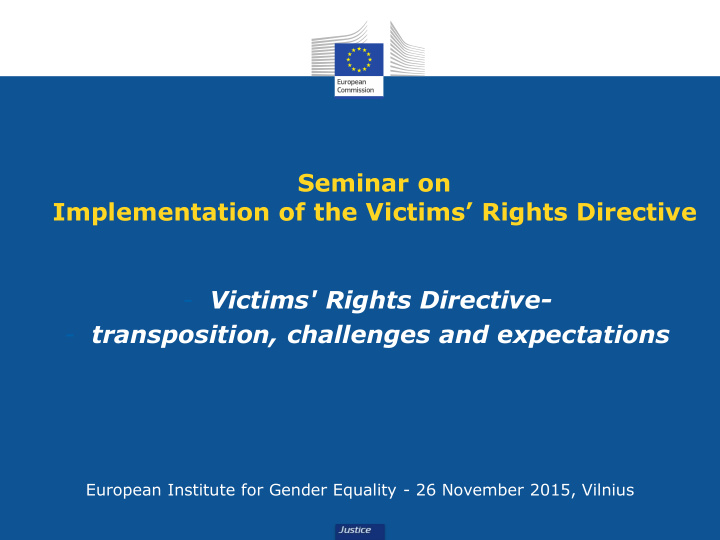



Seminar on Implementation of the Victims’ Rights Directive our Summer Course on EU Criminal Justice - Victims' Rights Directive- - transposition, challenges and expectations European Institute for Gender Equality - 26 November 2015, Vilnius
Victims' Rights Directive- transposition • Adoption 2012 – transposition deadline 2015 • Correct implementation of the Victims' Rights Directive in the Member States requires: legal actions (transposition of the Directive into the national legal orders by binding measures) and supporting measures (setting up of victims' support services, organisation of trainings, organisation of individual assessment) Need for national strategy on implementation 2
Victims' Rights Directive- transposition • DG Justice implementation strategy since 2012: guidance document on implementation of the Directive: http://ec.europa.eu/justice/criminal/files/victims/guidance_victims_rights_directive_en.pdf 4 implementation workshops Assistance on implementation and interpretation of particular provisions on request of particular countries 3
Victims' Rights Directive- transposition • Where do we stand in November 2015? - notifications to the COM of national transposition measures: -5 MS notified complete transposition (CZ,ES,MT,PT,SE) -8 MS notified partial transposition (BE,IE,FR,LT,NL,PL,RO,UK) • Other MS work on adoption of new measures (different stages of legislative process) • Possibly even 1/4 of the Member States have not taken any actions yet 4
Victims' Rights Directive- challenges • Certain provisions of the Directive more challenging than others? Article 2 - Definition of victim Article 4- Right to information - questions of practical application Articles 8 and 9- Rights to support services- leaves a large margin of discretion to organise in practice Article22- Right to individual assessment of victims needs to identify specific protection measures- equally large margin of discretion to implementation 5
V ictims' Rights Directive - Best practice (1) Examples of EU funded projects aimed at facilitating the implementation* (JUSTICE and DAPHNE programs): • Individual assesment- EVVI project, 2015 - handbook for the practitioners, template and recommended practices http://www.justice.gouv.fr/publication/evvi_guide_en.pdf • Comparative study on the theory and practice of diversity of treatment during the criminal trial identified ex ante shortcomings in legal / institutional frameworks of 27 MS (in 2014) http://www.victimsprotection.eu/images/4.38- Comparative-Report.pdf * Results of funded projects do not represent the official views of the European Commission 6
V ictims' Rights Directive - Best practice (2) - Examples of EU funded projects aimed at facilitating the implementation* (JUSTICE and DAPHNE programs): • Protection of victims – national protection orders and mutual recognition of protection measures, 2015 - EPOGENDER http://www.epogender.eu/ and POEMS http://poems-project.com • Development of multi-disciplinary and interagency services • PROMISE project (relevant for children, to be followed in 2016) http://www.childcentre.info/promise/ • *Results of funded projects do not represent the official views of the European Commission 7
Victims' Rights Directive - Other sources and ideas for cooperation: -Fundamental Rights Agency - reports and studies ,e.g. "Victims of crime in the EU: the extent and nature of support for victims", 2015 http://fra.europa.eu/sites/default/files/fra- 2015-victims-crime-eu-support_en_0.pdf -Victims Support Europe – handbook on implementation and capacity building support for organisations dealing with victims http://victimsupporteurope.eu/ - European Victims' Network – forum to exchange best practice and to discuss problems among the MS officials 8
Victims' Rights Directive- expectations The Victims' Rights Directive lays down a set of binding rules guaranteeing that all victims of crime are recognised and treated in a respectful, sensitive, tailored, professional and non-discriminatory manner If correctly implemented , the Directive has a potential of changing lives of millions of victims in Europe and of making Europe a better place for us all 9
Victims' Rights Directive- expectations Different groups of victims and their family members have rightful expectations from the Directive, for example: Victims of domestic violence – definition of violence in close relationship in the Preamble of the Directive, importance of provisions on access to support services and on individual assessment, access to information Victims of gender-based violence – definition of gender-based violence in the Preamble including gender identity, gender expression, importance of provisions on individual assessment, trainings of persons coming into contact with victims 10
Victims' Rights Directive- challenges • Commission is committed to ensuring correct and timely implementation of the Victims' Rights Directive On 16 November the Commission starts its enforcement strategy (legal, supporting and political actions) May, if necessary take legal actions against those Member States that would fail to transpose the Directive on time The correctness of the transposition will be evaluated in the second stage The Commission will also monitor correct application of the Directive in the Member States (dialogue and legal actions) • The Commission counts on active participation of the civil society in implementation and in monitoring of application of the Directive in particular Member States 11
Thank you ! Contact / Info: European Commission DG Justice, Procedural Criminal Law unit • Victims' rights' Team: • Sara Chrzanowska • Katarzyna Janicka- Pawlowska • led by Ingrid Bellander - Todino • E-mail: sara.chrzanowska@ec.europa.eu • https://e-justice.europa.eu/content_victims_of_crime-65-en.do 12
Recommend
More recommend